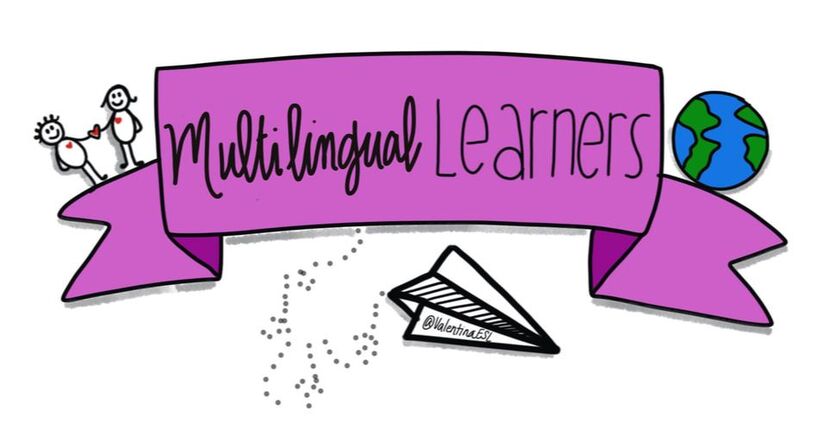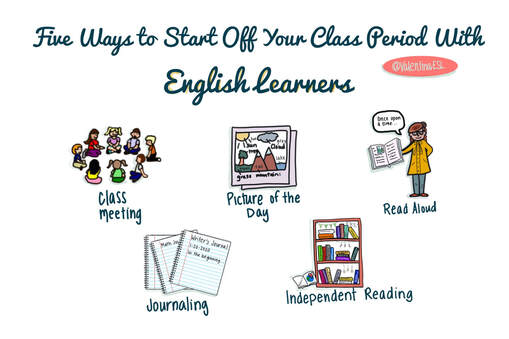|
The first thing we do with students can set the tone for our time together. Starting the period off on the right foot is critical to a successful lesson. Read on to discover five ways to start your class period in engaging and welcoming ways whether you are a general education teacher or an ESL teacher that pulls students out. 1. CLASS MEETING
A class or group meeting brings the group together into a community of learners. This method is excellent for groups of 2 or more. Some call this a Morning Meeting or Circle Time. The group forms a circle either with their chairs or seated on the floor and holds a 5-10 minute talk. The teacher facilitates the talk with guiding questions. In primary grades, class meetings can include songs, calendar time, weather update, etc.. In intermediate and secondary grades, class meetings include daily discussion topics. For example:
2. PICTURE OF THE DAY Even though the class meeting is probably my favorite way to start the day, picture of the day takes a close second. Take an engaging picture and display it for all students to see. Ask students to look carefully at the picture. After a few moments, have them discuss in pairs or groups: What do you see? What do wonder? What's happening in this picture? If you are working one-on-one with a student, let them take the lead when discussing. If they need assistance, provide them with sentence stems and primary language support. Whether you are working with one student or with a larger group, have students call out words as you label the picture in front of them. As a group, read the labels in unison multiple times for reading practice. Then come up with sentence for the picture. Finally decide on a few captions or titles. The best pictures are tied to academic content (math, science, social studies, reading, etc) and are compelling to students. I find great pictures both in texts and online. Through Picture of the Day, students are thinking, speaking, listening, and reading. Take it up a notch and have them write! 3. READ ALOUD Many teachers love to start the class period by reading aloud to their students. Reading aloud to all ages of students is beneficial. The first thing it does is calms kids down. Listening to a reader is a natural way to lower the affective filter and create a relaxing environment. But it's so much more. Reading aloud to the class models effective reading and English language structures. Reading offers higher levels of language and vocabulary than spoken language, so it's the best way to increase vocabulary. Many students can think at higher levels than they can decode. So when a teacher reads aloud a book a student can't decode, they are able to negotiate ideas and play with reading comprehension that they can't do with books independently. This practice is important. To make read alouds more supportive of English learners, we can incorporate:
4. JOURNALING In some classes, it is routine for students to walk in and take out their (math, science, reading, writing) journals. Teachers have a daily prompt for students and a set time to write. The more structure provided, the better the outcome will be. When asking students to journal, give them them a purpose and a plan. For example:
Remember that some students who are at earlier stages of English proficiency will need more support and accommodations. Some accommodations may include: providing visuals, allowing students to draw and label, offering sentence starters. 5. INDEPENDENT READING Stephen Krashen says that free voluntary reading does show great gains in vocabulary. But it's also one of the best way to become a stronger reader. Reading is a gateway to writing and language. With that said, independent reading can be a waste of time for some students if we don't support them. I was totally one of those kids in elementary school who didn't know what to do during independent reading time because it took me years to connect with reading. Don't get me wrong. I was a very good student and made As in my classes, but I faked reading for as long as I could. I sat behind the pages of my books and peered over them to see what kind of magic books had over everyone else but me... To support English learners and other students who need it with independent reading, we can confer with them one-on-one regularly. Simply sitting down with a student and checking in to see how they are doing, what they're reading, how it's going, etc. sends students messages that we care, that we won't give up on them, and that we're in this together. As we meet with students, we have the opportunity to build relationships and connect them with books that are not only on their reading level but also tie to their passions. We can also audit our bookshelves to ensure that our students are represented in texts. It's difficult to connect with books when we can't find common ground. Young readers want to feel they are part of the community. Representation helps with connection. So there you have it! 5 ways to start your class period with ELs. I've tried all five and love them all. Let me know your experiences with them and if you have others to add. 2/8/2020 06:30:29 pm
Hi, Valentina. Comments are closed.
|
Categories
All
|


 RSS Feed
RSS Feed
